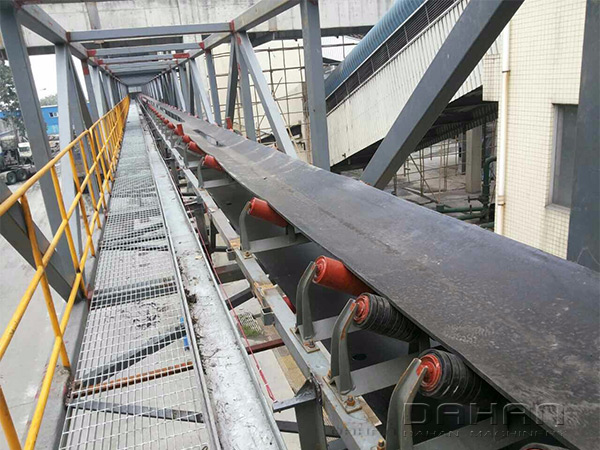Taking the belt conveyor transportation system composed of seven conveyor belts, five coal feeders and two coal bunkers as the model, this paper designs a control system with Siemens S7-300 PLC as the core to realize start-stop control and various fault protection under various working modes.

1. Hardware design
The controlled object of this paper is composed of 7 conveyor belts, 5 coal feeders and 2 coal bunkers. Among them, 5 # conveyor belt and 7 # conveyor belt are mutually blocked, 10 # conveyor belt and 11 # conveyor belt are mutually blocked. The realization of this project is composed of a control center on the well and a sub-station on the well. The control center is mainly composed of industrial computers and large-screen liquid crystal display (LCD) to realize real-time monitoring and monitoring of field data. The underground control substation is composed of programmable logic controller (PLC). It completes the on-site control of the field equipment, collects and transmits the operation status and protection signals of the equipment. Each control substation is connected through the field industrial bus and the control center on the well. This design chooses PS3075A power supply module of S7-300 PLC, field bus structure and CPU315-2DP for communication, 25 digital input points and SM321DI32*24VDC for certain margin, 10 digital output points and SM322DO16*DC24V/0.5A for digital output module. The analog input module SM331AI8 *14Bit is selected with 5 quasi input points; the industrial field bus PROFIBUS-DP is selected for communication network, and the communication rate is set to 1.5Mbit/s by default; and the touch screen is selected with Siemens SIMATIC touch panel TP177B6"colorPN/DP. According to the number of digital input points and the selected digital input module, the wiring schematic diagram of the corresponding module can be given. Among them, PD means the return signal of the conveyor belt motor controlled to open. Considering the universality, one belt conveyor is driven by four motors, but the return signals of four motors are connected in series and only displayed as PD. GM means the return signal of the coal conveyor controlled to open. Considering the universality, there are four coal feeders on one belt conveyor. In order to ensure that the equipment can be stopped, the conveyor belt motor closing button and emergency stop button adopt normal closed contacts; if the normal open contacts are used, when the breakdown causes the switch to be unable to work, the motor can not be stopped, causing major accidents and losses.
2. Software design
S7-300 PLC can adopt modular programming method, divide the whole system into several independent parts according to system requirements, and write programs for each part separately, which effectively reduces the complexity of programming. Taking the start-up module of belt conveyor as an example, the start-up process is briefly described. When the belt conveyor receives the belt start-up command, it transfers to the start-up program block. First check whether there is a protective signal action, if there is a protective signal action, stop starting the program, turn to the fault protection program, until the fault reset can start; if there is no protective signal action, check whether the front conveyor belt is open, if the front conveyor belt is not started, then withdraw the start command; if the front conveyor belt is not started, then withdraw the start command; if the front conveyor belt is not started. If the interlocking conveyor belt is opened, the start order will be withdrawn if the interlocking conveyor belt is opened. If there is no interlocking conveyor belt or the interlocking conveyor belt is not started, the alarm bell will warn for 10 seconds to start the conveyor belt. When the belt conveyor control system works, the motor may have over-current fault; the belt conveyor may have coal heaping, over-temperature, smoke, tearing, skidding and deviation and other faults. So when the system fails, it needs to enter the fault interrupt service program block. The analog signals detected by current sensors are converted into digital ones, and the over-current is judged by comparing them with the set threshold value; the first-level deviation does not need to stop, only need to alarm, and the deviation switch can automatically correct; the normal delay stops when the warehouse is full; the faults of coal piling, overheating, smoke, tearing, skidding and second-level deviation are more serious; You need to stop immediately.
3. The PC design
system uses force-controlled monitoring configuration software. Its basic components and programs include real-time database, engineering manager, human-machine interface, I/O driver and extension components. It has flexible design environment, complete redundant fault-tolerant technology, powerful compilation and operation engine, perfect alarm management, and is suitable for large scale applications. The characteristics of the design of the model of a type factory are discussed. The main interface of upper computer design system centralized control operation can realize centralized automatic control function and centralized manual control function in this interface. Specifically, there are transportation direction selection. Flow 1 represents the transportation direction of 5 # conveyor belt - 2 # conveyor belt - 1 # conveyor belt; Flow 2 represents the transportation direction of 12 # conveyor belt - 11 # conveyor belt - 7 # conveyor belt - 2 # conveyor belt - 1 # conveyor belt. Transport direction of conveyor belt; Flow 3 indicates the direction of transportation from 10 # conveyor belt to 7 # conveyor belt - 2 # conveyor belt - 1 # conveyor belt. When the centralized manual control mode is selected, the conveyor belt can be controlled separately. According to the actual production situation of the underground conveyor belt conveyor system in coal mine, this paper designs the conveyor belt conveyor control system with Siemens S7-300 PLC as the core, combined with touch screen design and force control upper computer software, to realize the control functions and requirements of various modes of control equipment, sequential start-stop, conveyor belt protection, etc.